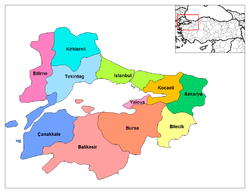- Marmara Region
-
The Marmara Region (Turkish: Marmara Bölgesi), with a surface area of 67.000 km², is the smallest but most densely populated of the seven geographical regions of Turkey. It represents approximately 8.6% of the Turkish national territory and about 30% of its population.
This region was officially put in existence after the Geography Congress of 1941 in Ankara and is geographically divided into four regional parts, or areas.
Its name derives from the Sea of Marmara, which itself is named for the island of Marmara.
Contents
Provinces
- Balıkesir Province
- Bilecik Province
- Bursa Province
- Çanakkale Province
- Edirne Province
- İstanbul Province
- Kırklareli Province
- Kocaeli Province
- Sakarya Province
- Tekirdağ Province
- Yalova Province
Geography
The Yıldız Mountains and Uludağ are in the Marmara Region. Islands in the Aegean Sea are Gökçeada and Bozcaada, and in the Sea of Marmara are Marmara Island, Avşa, Paşalimanı, İmralı and the Princes Islands of Istanbul.
Climate
İzmit Climate chart (explanation) J F M A M J J A S O N D 9510377103711355618945231350281743291953291951261692211389168107125Average max. and min. temperatures in °C Precipitation totals in mm Source: Turkish State Meteorology [1] Imperial conversion J F M A M J J A S O N D 3.84938351382.856412.265481.874551.982621.785672.18567278613.669553.560474.25342Average max. and min. temperatures in °F Precipitation totals in inches The Marmara region has a hybrid mediterranean climate/humid subtropical climate on the Aegean Sea coast and the south Marmara Sea coast, an oceanic climate on the Black Sea coast and a humid continental climate in the interior. Summers are warm to hot, humid and moderately dry whereas winters are cold and wet and sometimes snowy.
See also
References
External links
- (Turkish) Golyaka Village, Bursa
Census-defined regions of Turkey Aegean · Black Sea · Central Anatolia · Eastern Anatolia · Marmara · Mediterranean · Southeastern Anatolia
 Categories:
Categories:- Regions of Turkey
- Marmara Region
- Marmara Region geography stubs
Wikimedia Foundation. 2010.


